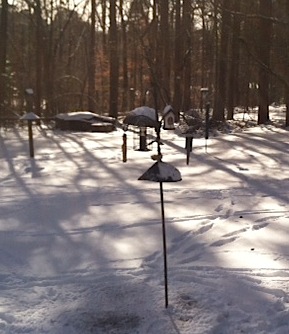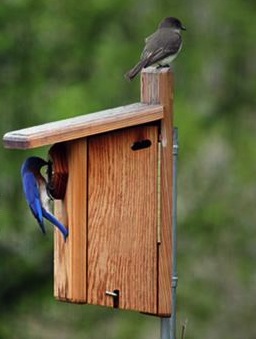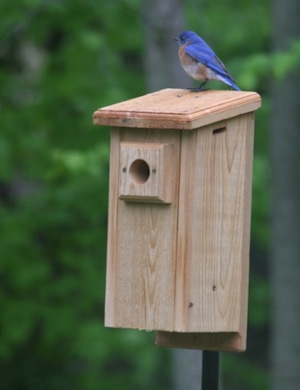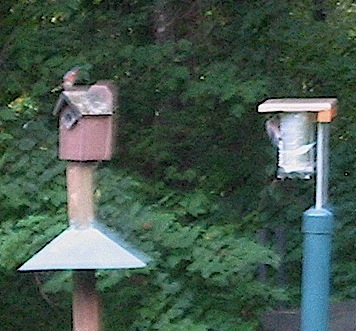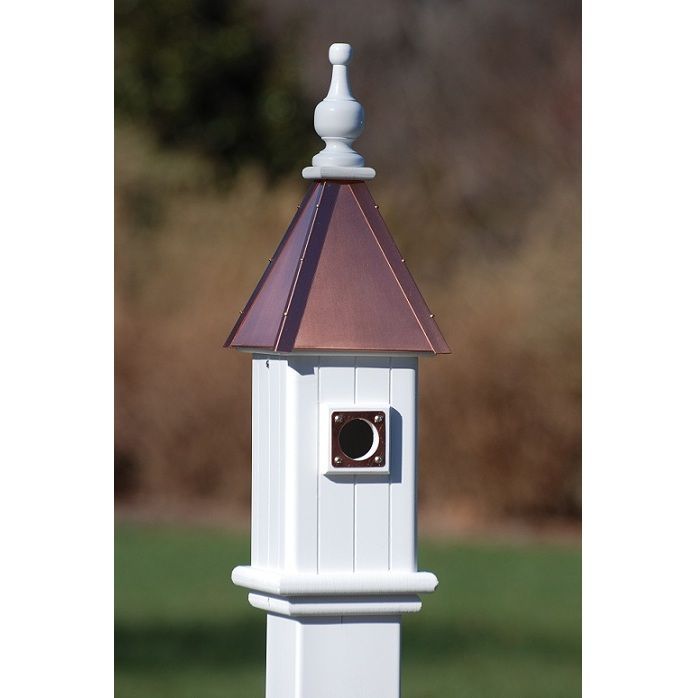-
They’re Scouting Bluebird Houses Already!
Despite adverse conditions of the polar vortex and another extreme winter, bluebirds and others are on the move, searching for suitable digs to raise their young. Even though snow is covering most of the country, Mother Nature’s biological clock tells them it’s time, the calendar and number of daylight hours is what lets them know.
Early migrating birds on the Atlantic Flyway like swallows, warblers and flycatchers rely on insects as they island hop through the Caribbean onto Cuba. When making landfall along the gulf states, their usual smorgasbord of insects, flowers, fruits and berries will be be scarce. Many neo-tropicals, including hummingbirds run the risk of depleting fat reserves before they reach spring breeding grounds here in the US. Simply put, if you think the weather has been an inconvenience – it makes life miserable for wildlife as well, and many birds just won’t make it 🙁
Closer to home, over-wintering residents like bluebirds are already checking bluebird houses to claim for nesting and raising their broods. With snow on the ground and high temperatures right at freezing, you can hear birds belting out their breeding songs! If there was a way to say “wait… it’s still too cold!” we most certainly would-but then again, man is no force against nature.
Best we can do is help feathered friends along the way by offering fresh water, food, and birdhouses that are ready for nesting. If you haven’t done so already, please check your bluebird houses and remove old nests. Be sure they are secure, sturdy and ready for vacancy. If you can stomach it, live mealworms are their favorite, but suet, peanuts and sunflower hearts also offer much needed fat and proteins.
An Eastern Phoebe perches atop this bluebird house while the male checks out its interior. Phoebes won’t use these houses, but may take up residence in barn swallow nest cups if you offer them in sheltered areas around your home.
During this treacherous weather… please help birds and wildlife with supplemental feeding and a heated water source… thanks on behalf of the birds 🙂
-
some blue bird houses are seeing 3rd or 4th nesting!
It’s been a strange season for birds in general due to the lengthy winter weather. Because some parts of the country were still seeing snow in late April and early May, mortality rates among nestlings were higher than usual. Colder than normal temps along with scarcity of natural food sources may have also accounted for some unsuccessful migrations of favorite feathered friends like hummingbirds. Many folks have reported seeing fewer of these sprites around feeders early in the season this year.
On the flip side, resident birds whose nesting season is about over, are attempting later than usual broods. Many blue bird houses which have already fledged two or three sets of nestlings are seeing their third and even fourth clutch of the season! This is all wonderful news for bluebirds… except for the searing temperatures July and August can bring.
If it’s hot outside, guaranteed it’s hotter inside a birdhouse. Babies can not regulate their body temperatures until they reach a certain age, but there are a few things you can do to help bluebirds (and others) beat the heat. First and foremost is to keep blue bird houses out of the sun, especially that baking afternoon sun. Moving a box a few feet where it’s shaded in the afternoon makes a difference in the ambient temperature inside the box. To featherless nestlings, just a few degrees can mean the difference between life or death. Birdbaths and Leaf Misters also help birds cool down during extreme heat. Parents will even shake themselves over babies dripping a bit of water to cool them.
Crazy as it sounds, there are other ways to cool down blue bird houses. Setting an ice pack or two on top of the house, attached with a large rubber band or bungee will help to cool temps inside. Recent discussions revealed a few folks putting up umbrellas to shade their nest boxes, again attached with bungee cords. Last summer we even wrapped our
Gilbertson nest box with a heat shield – the kind used for car windshields! Easy to measure, and simple to cut, duct tape and rubber bands held the soft shield securely in place. The blues didn’t mind it all, and it helped their digs and babies stay cooler. Four fledged in mid-August of 2012. Stats like these mean it’s not too late to offer bluebirds housing. At the very least, you may be providing a nightly winter roost for other resident birds.
The image isn’t so great, but you can see the foil-like cover on the round blue bird house to the right. It literally took five minutes to complete this easy project, and may have helped save four babies from succumbing to horrid heat.
-
Attracting the right birds takes research (pertaining to bluebird houses)
This letter to the editor appeared in The Journal Gazette, Fort Wayne, IN., a few days ago. We thought it might be of interest to those who are newer to backyard birding and so fascinated with all their feathered visitors. Because all songs are not always good ones, we believed this post was in order, especially when adding bluebird houses around your yard.
“Attracting the right birds takes research, effort
Eight years ago, when my husband and I moved to the Spencerville-Leo country area, I decided to put out a birdhouse. Soon our birdhouse was occupied by a pair of bluebirds and five blue eggs. I thought how easy and why was attracting bluebirds thought to be such a hard task? Unfortunately, I discovered the answer. The main problems for bluebirds are house sparrows.
House sparrows are extremely destructive to American species of birds. House sparrows make a point of taking over nesting sites. Sparrows often and viciously take over nesting boxes inhabited by our American species. They trap adult birds in their nesting boxes and kill adult birds by pecking the skulls. Sadly, sparrows most notoriously attack the baby birds also. Sadly, in one summer I have lost as many as 11 bluebirds, mostly attributable to the sparrow and another non-native American bird, the starling.
If you are thinking about feeding birds or housing birds in your backyard, please be aware of what types of birds you bring into your area. Monitor your nesting boxes often to make sure you are attracting the birds you desire.
Now I feel like I’m starting over attracting bluebirds, but they are well worth the effort. As for my personal opinion toward house sparrows, they are nothing but trouble.
LAURA McCANN Spencerville”
Not all sparrows are bad, so it’s best to familiarize yourself with their identification by their song and plumage. Simply do a search for the ill-willed, non-native bird, and images with tons of resources will appear. Note the differences in male, female and juvenile birds as well. If you are serious about attracting bluebirds to your place, this information will serve you and the birds very well!

